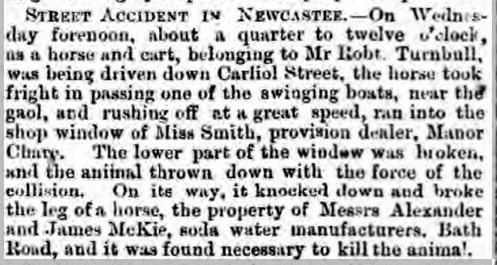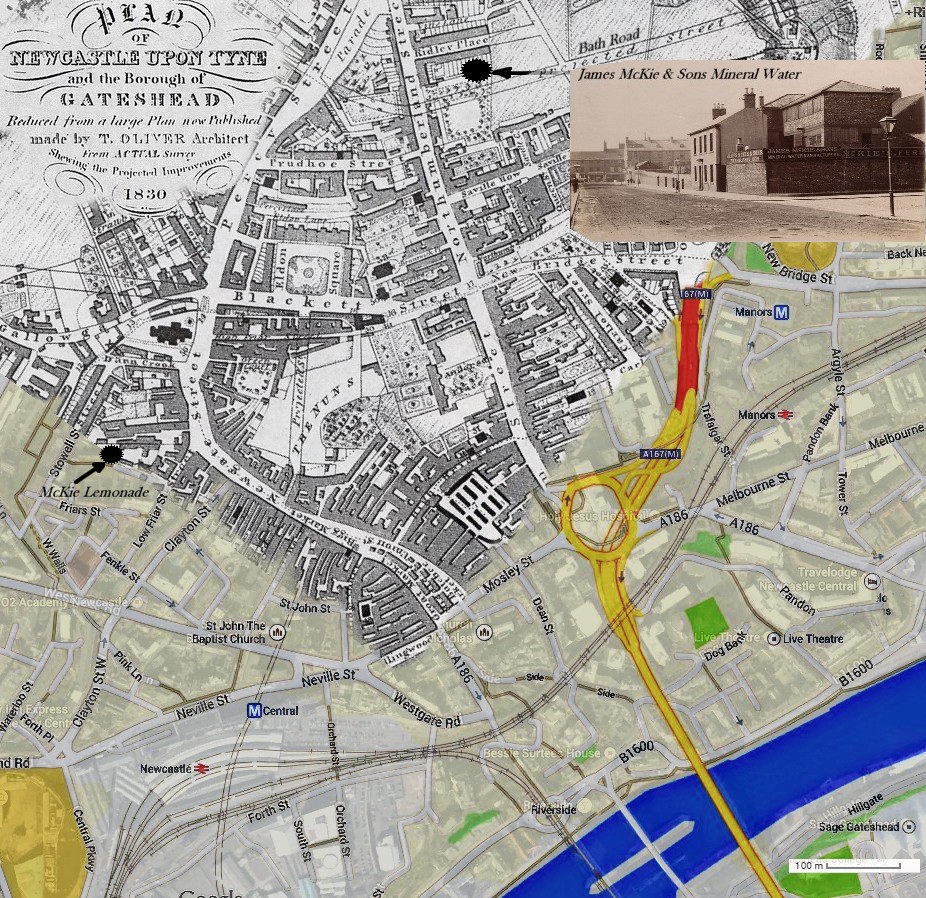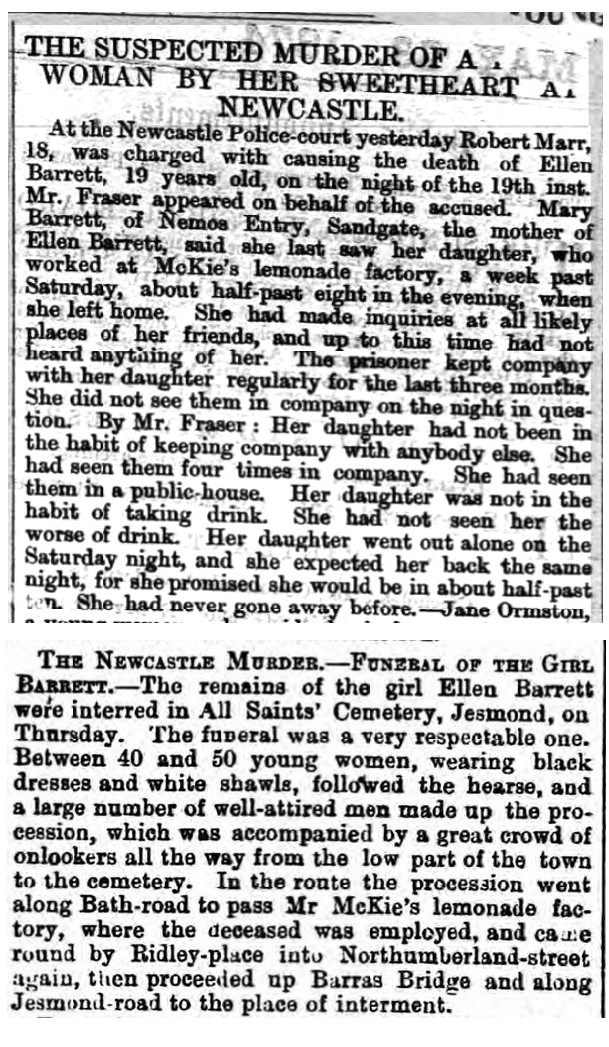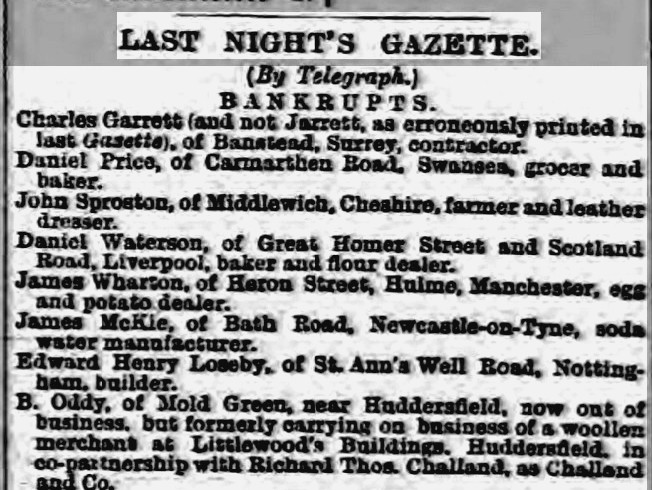The next generation arrives
By 1847 William McKie was taking an active interest in the life of the community. He was a member of the expatriate Scottish Diaspora in Newcastle and his sons followed in his footsteps, despite being first generation Englishmen. We have to imagine him bearded in the garb of the day: a long black frockcoat and top hat, perhaps with a silver-headed cane.
William and several associates on the committee of management took out advertisements in several newspapers in support of arrangements for the Close Schools. It suggests rather strong religious prejudices:
Newcastle Courant 28 May 1847
|
|
|
In to this upright environment a new McKie unexpectedly arrived in 1849, after a 13-year gap, when Margaret was 53. Their daughter Jane, now 17, had become a dressmaker, a profession, and a name, that is commonplace among my ancestors on both sides of my family. In the following census little George was listed as their son.
But ten years later neither Jane nor George still lived with them and I can find no further convincing record of either. Perhaps they emigrated.
The two older boys Alexander and James were now young men about town. Alex McKie met a good Scottish (he would have said Scotch) girl Mary Watt. They were both 18 when they married in 1852. Maybe she lost a baby or two because there is no child for some time but they eventually had three girls and a boy (Margaret, 1856; George William, 1859; Annie, 1865; Janet, 1867).
James, my great great grandfather, would soon follow his brother's lead. James had met a local girl, Elizabeth Lawson, and married her in 1857 when they were both 21 years old. The boys may have met their future wives at their Scots Church (Presbyterian) where they were Baptised. Church was the great nineteenth century meeting and mating place.
Elizabeth was the daughter of James and Frances Lawson (nee Dowse). They lived in nearby Orchard St in the same Parish (St John).
Meanwhile, William or Alexander or James (its not clear which) were sorting out the problems of being an employer and the foibles of mankind, confounded by that dreadful curse: alcohol.
Newcastle Guardian and Tyne Mercury 26 November 1859 |
|
|
Elizabeth and James' first child James (Junior), my great grandfather, was born in 1859; followed by Margaret Jane, 1860; Frances Ann, 1861; Elizabeth, 1863; Mary, 1865; and my great uncle, Jacob Lawson McKie, 1870. Jacob is important later in our story.
In December 2017 David Hopper, Frances McKie's great grandson contacted me. David's provided the following information:
|
Below is a photograph of Frances 1861-1909. She married a John Reid and she had 2 sons: Stanley & Lionel. Stanley was my grandfather. His brother Lionel left home and went work in the Russian oilfields as a secretary. He was an early member of the SIS working in Russia during WW1 and the revolution. He was awarded a military OBE in Vladivostok in 1917. The SIS later became MI6 which he worked for mainly in the Eastern Bloc until his death in 1953. Frances was deaf later in life and she had a very unhappy marriage until her untimely death in 1909, possibly suicide? |
|
|
This stimulated me to get to the bottom of this, to me at least, confusing 'cousin' thing:
Family RelationshipsCousin First Cousin, Full Cousin *Guidance provided by Jennifer Crichton's 'Family Reunion' |
Thus, David is my second cousin. He's also second cousin to my brother Peter, as well as to our first cousins: Shelia; Pamela; Patricia; and Jane.
Back to the story:
Both Alex and James now took active roles in the business and both declared themselves proprietors in the 1861 census, when it was still located at Dispensary Lane.
Now the lemonade business could be called McKie & Sons.
As the city grew so the McKie lemonade manufacturing enterprise also grew. New products were developed, like ginger beer, and the business was renamed a soda water factory. But the original location was less than ideal. It was time for a move to a more salubrious location.
A hundred years later the whole Dispensary Lane and Square area would be condemned as a slum.
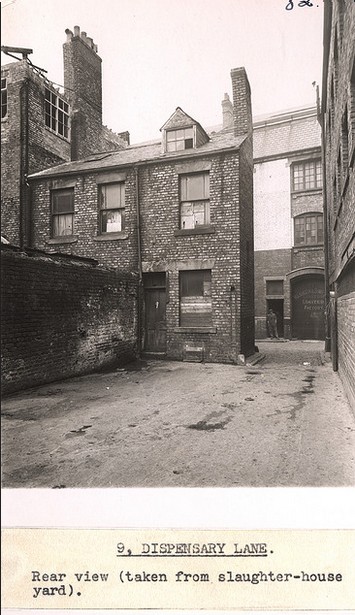
A century later - a slum
The buildings they occupied there have since been demolished and rebuilt as up-market dwellings. Dispensary Lane's most recent claim to fame was a rape - perpetrated by a 'painted man' - a rapist wearing makeup.
With the new Water Corporation came the first public baths, a grand building constructed out in what was then the semi-rural Parish of St John, serviced by a newly constructed Bath Road off Northumberland Street.
Richardson's descriptive Companion through Newcastle upon Tyne
|
|
CHAPTER XIV. MISCELLANEOUS ESTABLISHMENTS FOR THE ACCOMMODATION OF THE PUBLIC. PUBLIC BATHS After a number of meetings for the purpose of deciding upon the best plans and arrangements, it was finally determined, at a meeting of the shareholders and others, held on Tuesday, August, 27th., 1837, to immediately proceed to erect the public baths* according to designs submitted by J. Dobson, Esq., architect, who had visited most establishments of the kind in England, for the purpose, if possible, of improving upon their construction. *Upon the corporation granting this contract, the committee invited the skill of the town and neighbourhood in order to determine, by analysis, the most wholesome water that could be obtained for the supply of the town and the result of the tests proved the purity of the Coxlodge springs, which was confirmed by professor Black of Edinburgh, and Dr Saunders, an eminent chemist of London.
|
|
|
What better new location could there be for a soda water factory than adjacent to the Coxlodge springs, recently endorsed by professor Black of Edinburgh, and Dr Saunders? And so 400 yards down Bath Road from the new baths, west towards Northumberland Street, land was acquired and William McKie and his sons, Alexander and James, set up the McKie and Sons Soda Water Factory, with new, finer, accommodation for the family.
The year Jacob was born there was a little drama in Carliol Street when Mr Turnbull's horse ran amok.
Newcastle Courant 12 August 1870 |
|
|
A swinging boat was a kind of two-person swing, popular in the north-east of England at the time (a shuggy boat), where a couple would sit at either end and pull on ropes to swing the 'boat' higher until the ends were swinging above the fulcrum, the origin of the word 'skylarking'. The modern fairground equivalent is a swinging 'Pirate Ship'. Why there were several in Carliol Street near the gaol in 1870 is a mystery that Google Street View fails to shed any light on.
So, a couple skylarking scared a horse that ran amok and generated a media report. As a result of this unlikely set of circumstances they inadvertently left a message for generations to follow, confirming that the McKies had moved to Bath Road before August 1870; that the McKie sons were in the process of taking over the reins from their father; that they no longer called themselves lemonade manufacturers; and that they had previously owned at least one horse.
Collage of maps of Newcastle upon Tyne
|
|
|
By the time of the 1871 census William and Margaret had taken a step into semi-retirement, with the assistance of a Scottish servant named Janet Hair.
In 1874 the business was news across the region. This was one occasion when the adage: 'there's no such thing as bad publicity' was true: An employee, Ellen Barrett, fell into the River Tyne while out for the night with her boyfriend.
Her young man Robert Marr was arraigned for her murder.
He had bought her a shawl earlier in the evening and perhaps wanted a favour in return and after the public houses closed, they made their way to the quayside and sought the privacy provided by a 20 ton crane. Several other young people were also in the area and heard them quarrel. She wanted to 'come away'.
Then they saw Robert running off. So, they looked for Ellen, in vain. Two days later her body was found on the other side of the river in a decomposed state.
Did Ellen fall or was she pushed?
Morpeth Herald 30 May 1874
|
|
|
Ellen had friends who also worked at the factory who were very distressed. Her large funeral cortège was routed past the McKie Soda Water factory.
Robert Marr was eventually convicted of manslaughter and sentenced to penal servitude for a period of 12 years. He left the dock protesting his innocence, as well he may have been as the evidence was circumstantial. But he was never going to walk free. If it had been an accident, he hadn't attempted to save her. He hadn't even given the alarm but ran away. He probably couldn't swim and panicked but he'd pay for that.
At around the same time in 1875 Alexander McKie too had died at the age of 41. He left his wife Mary McKie a widow with four children, aged 8 to 19. The business name was back to McKie and Son, singular.
If Alex's death wasn't bad enough at the age of 19, James McKie Junior, James' son, impregnated Mary Ann Ritchie who was also 18 or 19. They were married in the second quarter of 1878 and around three months later their first child Mary Ann McKie (junior) was born.
Were they forced to marry or where they in love?
Although premarital sex was a common occurrence, it was considered very lower class and not the norm or to be hushed-up in respectable middle-class society. This was particularly the case in our family where the patriarch had spent his life bettering himself from an itinerant labourer to become a respected businessman and a pillar of the Presbyterian Church. The timing of this birth was something they wanted to cover-up so they lied about the baby's age in the 1881 census.
All this seems ridiculous today, when none of their descendants would marry someone they hadn't lived with first or who they considered to be a suitable potential life partner. But then it's unlikely they would give birth to an unwanted child either.
Had the family been comfortably a bit higher up the social ladder or less enthusiastically religious the pregnancy might have been handled differently. Mary Ann herself may have been surprised at being obliged to marry. She was the daughter of Ann Ritchie or possibly Isabella her sister, neither of whom was married. Ann and Isabella were the daughters of Robert and Mary Ritchie and they both worked as servants.
It seems that there was retribution. James McKie Junior was expelled from the family home in Bath Road. My great grandfather's family initially moved to 12 &14 Thorpe Street, since demolished and now what looks like public housing in Google Street View. Then they moved to 65 Meldon Terrace Heaton and this is where my grandfather spent his childhood. You can still see this modest terrace-house on Street View.
On August 20 1879 one James McKie, of Bath Road, Newcastle-on-Tyne, soda water manufacturer, was declared bankrupt.
Western Daily Press 20 August 1879 (and others) |
|
|
But two years later James McKie and Sons, Soda Water Manufacturing, remained a going concern in Bath Road, employing 15 Men, 4 Boys and 4 Women. So we can conclude that either there was a temporary problem in the business or it was James Junior who was unable to satisfy his creditors in 1879.
It seems that it was James Junior who was unable to call on the family assets as he had been cut off and was now out of the succession.
Old William McKie the patriarch died a year later 1880 at the age of 77, possibly exacerbated by the scandal, and it's probable that he was responsible for young James's financial plight or possibly for a reversal of the bankruptcy. Margaret outlived him by four years and died at the very old age at the time of 87.
The stigma of the marriage seems to have been more about hushing-up my great grandmother's background than about a child arriving early. Although she contributed a sixteenth of my DNA, I had never even been told what my great grandmother's maiden name was - I always assumed it was Lawson. I did know that there was a family scandal about an unplanned pregnancy involving a maid. But that was as much as I was ever told. Through a process of elimination, delving into the records, I now discover that my great grandmother was Mary Ann Ritchie.
Her anonymous father is one of the three of my sixteen great great grandparents who remain unknown to me, it's interesting that all the known men had a skilled trade or were in business. Presumably my great grandmother's father was her mother's employer or an associate of her employer. Maybe he was someone academically brilliant? There were a lot of candidates in Newcastle back then.
Mary Ann's unmarried mother was one of my great great grandmothers. Her father, my great great great grandfather, was Robert Ritchie, a joiner from Gateshead. His wife was Mary but it's not possible to identify their parents. Like McKie, the Ritchie family name has origins in Scotland and Ireland. At the turn of the century the name distribution was similar to McKie but they are far more numerous.
James McKie (senior) was now in full control of the business as can be seen in the early photograph below. But it is now Jacob McKie who will succeed.
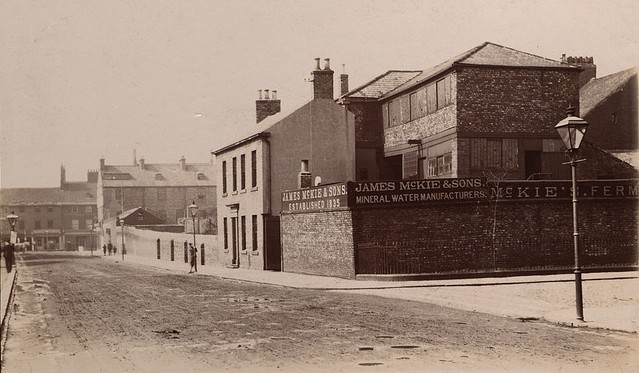
James McKie and Sons in 1898 - in Bath Road (now Northumberland Road). Northumberland Street is in the distance.
The Public Baths are on the same side, a block behind the camera.
The side street, Ridley Place, is now John Dobson St, the major crossroad in the 2010 image above.
Note the gas street lights. This type employed the newly introduced gas mantle, producing a brilliant white light.
These were leading edge technology and delayed the introduction of electric lighting in locations like this and in Sydney.
Around the time of the 1898 photograph Bath Road was renamed, rather confusingly, to 'Northumberland Road' and the baths became the Northumberland Road Baths.
As the colour photograph from 2010 shows, the baths are still there today, but I doubt that gentlemen of the upper class still have an exclusive section.
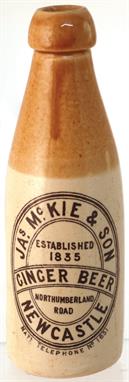
Ginger Beer bottle marked Jas. McKie and Son Northumberland Road
What happened to 'Sons' ?
Note that we now have a telephone
Mary Ann McKie bore James McKie Junior five children: Mary Ann McKie (junior) in 1878; James William Lawson McKie, my grandfather, in 1881; Margaret a year later; then Thomas another year later; and finally, Laura in 1887.
Then some time after Laura was born, Mary Ann McKie (the elder), my great grandmother, completely disappears from the records. She was no longer a member the household of James McKie Junior in the census of 1891.
I have been unable to find a death notice for her anywhere in England. But there was a married woman called Mary Ann McKie, in a single berth, leaving for New Zealand in 1908. There was also a press article in the Northern Echo of 6 November 1900 about the wife of one J McKie, who may or may not be related, who was sewing for maintenance on the grounds of desertion.
By 1891 James' sister, Margaret Jane McKie, had moved in at 65 Meldon Terrace and they now had a live-in servant too: Mary Heywood (aged 18).
There must be a lot of drama at home when my grandfather had his mother either leave, or perhaps die, at the age of 9 or 10 and he acquired his aunt in her place.
In September 1897 James McKie (senior) died leaving Jacob McKie in control of the water business.
Hartlepool Mail 30 September 1897 |
|
|
Notice the business name is 'McKie and Son', singular.
Then in 1905 Margaret Jane died at the age of 41. Five years later in 1910, James Junior was dead too at the age of 51. I don't know the cause. But my father talked darkly of alcoholism in the family, warning Peter and me not to over-indulge. Given his circumstances he may have simply given up. All the McKie men were dying young, except old William who lived to the age of 77. As we will see, at least one death was a suspected 'felo de se'.
Both of James' and Mary Ann's boys: my grandfather, JWL, and Thomas McKie had left home soon after their aunt died.
My grandfather's unmarried sisters Mary Ann (31) and Laura (23), now parentless, moved in with their uncle, Jacob McKie, at Number 1 Northumberland Road. Jacob was now the inheritor of the McKie Water business together with their aunts Elizabeth and Mary. In the census Laura is listed as a typist in the business.
They and my ancestor had parted ways.

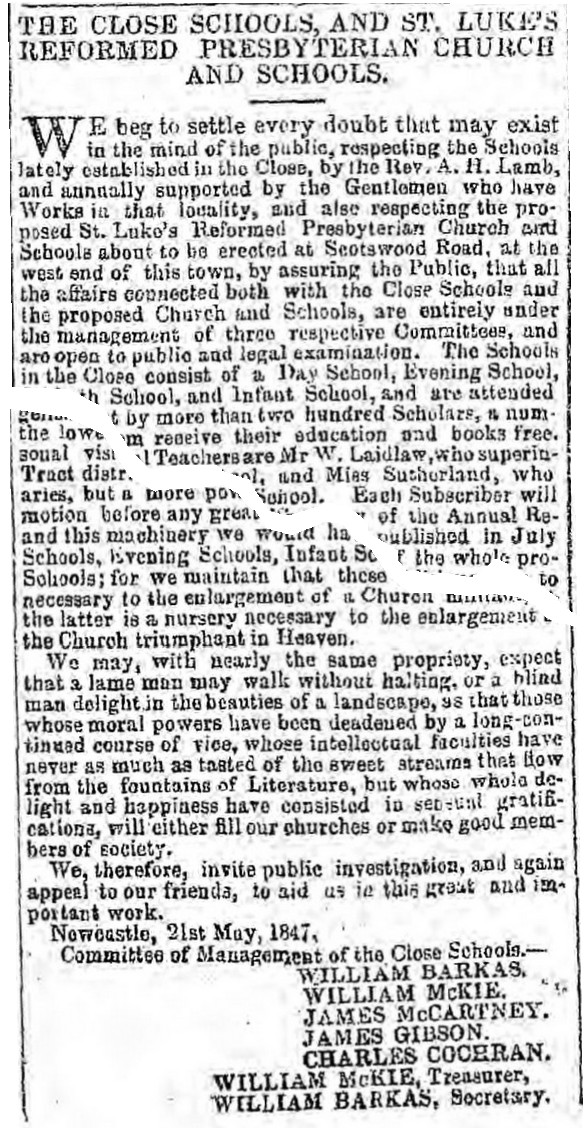
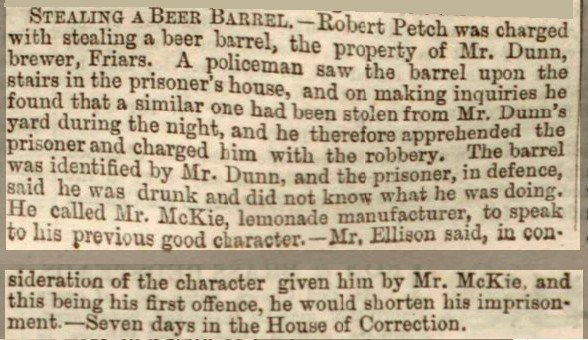
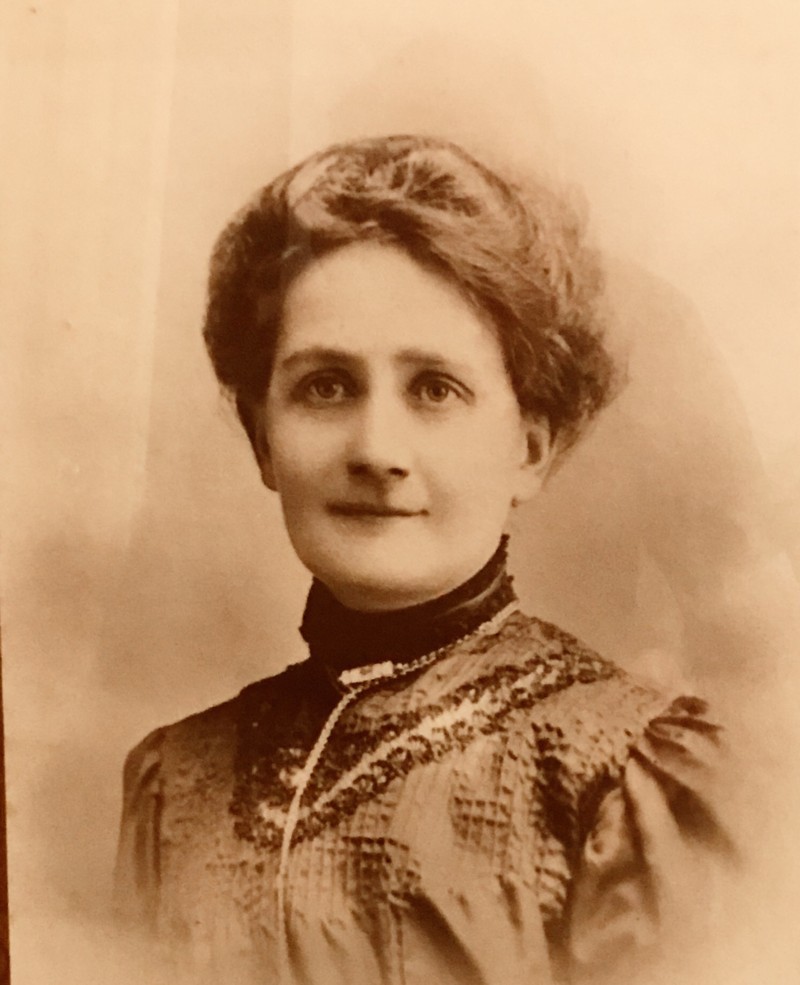 Frances McKie - provided by David Hopper
Frances McKie - provided by David Hopper
